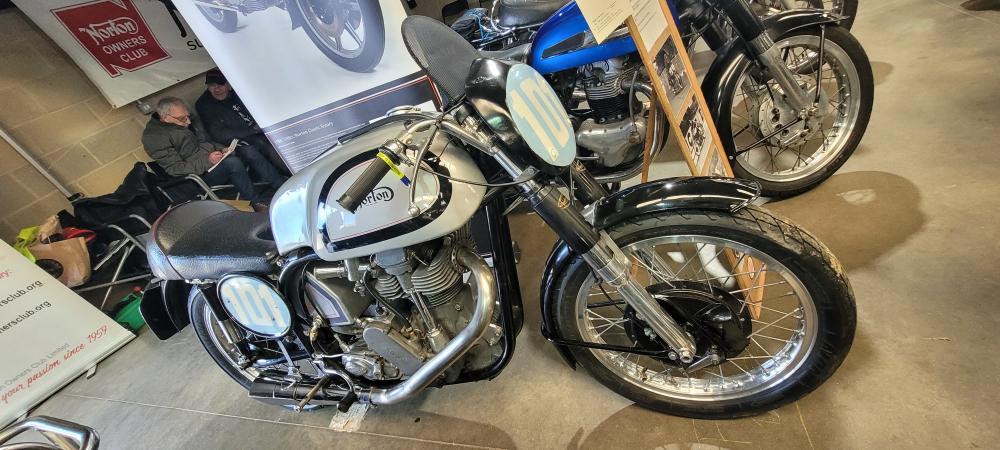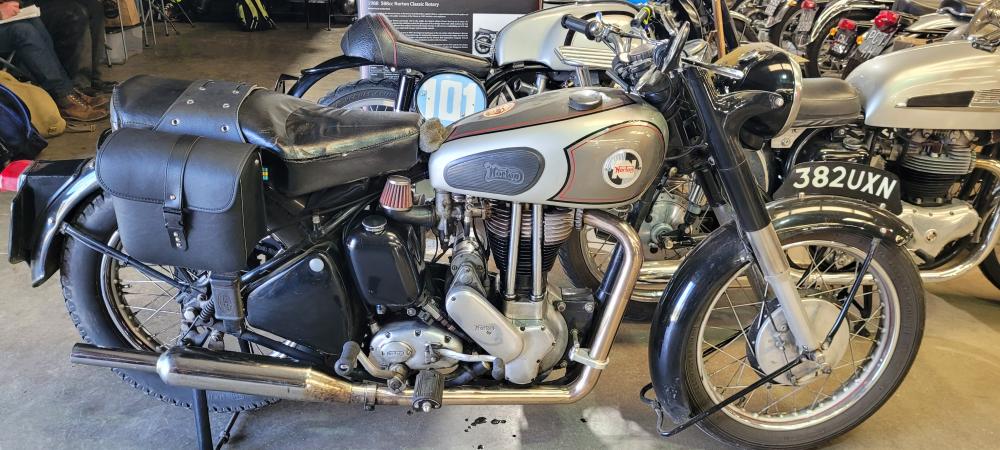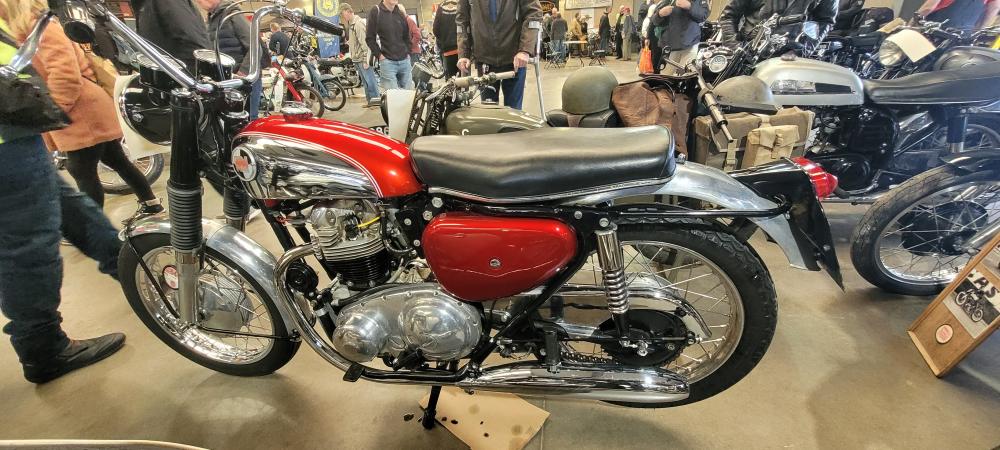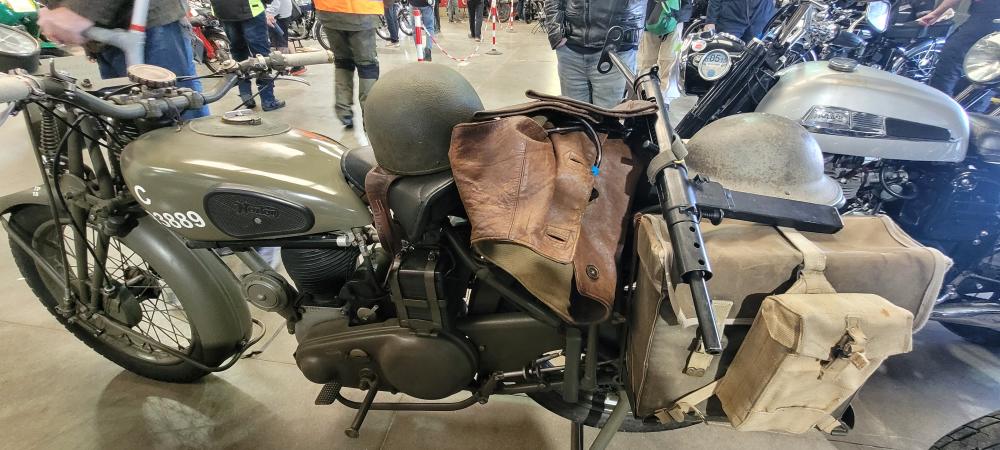A review of correspondence from Roadholder and NOC-L
The causes of cylinder head oil leaks, stretched studs, leaky gaskets and a number of recommendations for various sticky products to help with these problems
Halite head gaskets and torqueing up
The only cylinder head gasket to use is the standard steel ringed halite gasket. One problem, is in using gasket jointing compound on the head gasket. Do not do it. Thoroughly degrease and dry the joint faces and use a clean gasket; do not use any jointing compound, oil, grease, or anything else. Tighten the head bolts in the correct order, but do not apply the torque the first time. Start by tightening all the fasteners to 50%, then go round again at 75%, then 90% and finally 100% (full torque). Having done that, go round again twice applying 100% torque. After 100 miles or so, check again by retightening to 100% with the engine cold.
Bob Stapleford in Roadholder
Copper head gaskets and torqueing up
I raced 750, 850 and even 920 Commandos for some years using copper head gaskets. They never blew, but they always seeped oil. After rebuilding the (road) engine on my current Commando with a composite gasket for the first time, it threw oil out like it was going out of fashion. The Wise Men told me the secret is to retorque it frequently until it stops moving, as quite a lot of settling happens during the first few hundred miles. So, I retorqued it after the initial warm up and every ride thereafter for about 400 miles, and what do you know - they were right. Oiltight. Quite unnerving. The primary chaincase leaks of course, but I call that character.
Des Senior in Roadholder
Head leaks may come from the inlet rocker cover
Be sure there is no oil leaking from around your intake rocker cover. Oil leaking from there can be drawn forward through the small holes in the barrels that are between the cylinders. This is apparently done by a vacuum effect. It is then blown around by normal air passage and makes it look like a front cylinder head leak
I learned this from Brian Slark years ago when I thought I had a recurring cylinder head leak.
Also, Leo Goff recommends replacing the cylinder head studs after 2 head removals, as they have a tendency to stretch.
Jim Noll in Roadholder No. 162 - Mar/Apr 1992
Sealing copper head gaskets - a product recommendation
|
My Mk.lla Commando is just being run in, and has already started pissing oil from its copper cylinder head gasket. OK, the head needs to be torqued down a bit and that might be why the seal has broken so soon (150 miles) but shall I just put on an eyeletted one instead? Or, will a bit of gasket sealant help around the push rod tubes do it? |
This is an on-going dilemma. The correct answer depends on the situation. Though the eyeletted (or flame ring) gasket is superior at sealing the push rod tunnels, its main drawback is its fragility. You say that your copper gasket has got to the point of seeping oil .... had it been an eyeletted one, it would have been blown by now! I prefer the copper gasket because of its durability. However, to seal the tunnels, I use a high temperature sealant around the tunnel holes on the head, barrel, and gasket. My long-term favorite has been K&W Copper Coat, which comes in a can. (I think there is a spray-on kind made by someone, but it is not the same). It is composed of the sealing liquid, which has ultra-fine copper 'dust' in it. Prior to using, you stir the liquid to disperse the copper dust in the liquid, so that it can fill minor imperfections in the mating surfaces. On good surfaces you need only a thin coat ... if you're suspicious of certain areas (like around water jacket holes in an automotive block), you can selectively build up areas with multiple coats, allowing the copper dust to settle in the hollows. Not a cure for dressing your mangled mating surfaces, but perfect for those slightly marginal ones. Copper Coat acts like a contact sealant, since you brush it onto the surfaces to be sealed, let them get tacky, and then bolt them together. It works very well on Commando heads, between crankcase halves, etc. The advantage is that even on the cylinder head application, Copper Coat will not harden, or burn when used on the cylinder head joint.
Gregg Kricorissian (grkricor@ccs.carleton.ca) on NOC-L 17th. Apr 1997
Sealing copper head gaskets - not advised
|
Never put any gasket sealant on a head gasket. It only gets in the way and makes things worse. A flame-ringed gasket will work perfectly well if the gasket faces are in good order. If these are warped, the flame-ring gasket will blow. Normally a rider will then fit a copper gasket, since "it doesn't blow like those flame-ringed ones used to". It does, of course, it just doesn't blow the gasket to bits every time it does so. With a warped gasket face, a copper gasket will blow and blow and blow until one or both gasket faces are totally ruined, the oil is full of water-emulsion and acids and the entire top end has to be thrown in the bin and replaced. Falsehood No1: "Copper head gaskets don't blow". They do. |
Whenever removing the head of an unfamiliar Commando, inspect both gasket faces; they are almost certain to be warped, owing to the mechanical ineptitude of most '70s motorcycle riders. Reface them. You'll go up a maximum of 0.1 atmospheres compression, even if the damage is really bad. The work will cost around £40-£60 tops here in the UK, if you remove the head and barrels yourself and take them to the shop. Never put gasket sealant onto a flame-ringed gasket. The gasket itself is treated with Hylomar gasket sealant, in two grades, top and bottom. The top sealant is designed to bond to alloy, the bottom sealant is designed to bond to cast iron. Any foreign gasket sealant applied by yourself will only get in the way and prevent the built-in sealant from working, causing blowing. The gaskets are labelled 'TOP' and 'BOTTOM', so you know which way up to put them (they've got a little hole for the oil drain tube on either side, but that's only there in case the gasket is put on upside down by mistake). Les Emery then follows this procedure, for torqueing down the head.
- Tighten down the head bolts loosely, all round
- Torque No1 (the 1/4" Whitworth headed cycle thread bolt in the middle) to 30 foot pounds, as recommended
- Follow with the 1/4" Whitworth headed nut at the back, then all the others, as described in the text of the manual.
- Give No1 bolt, (in the middle) another 5 foot pounds torque (35 foot pounds in total)
He says this is a little naughty, but works out as an almost foolproof method of torqueing down the cylinder head.
D.J. Walker (djw12@leicester.ac.uk) on NOC-L 17th. Apr 1997
Sealing copper head gaskets - a product recommendation
Before there were 'good', (Blue Fel Pro Brand), Big Block Chev head gaskets available, the only way to ensure a long lasting, non leaking, head gasket seal on a B/B race engine, was to use Permatex Super #300 during assembly. I understand it was originally formulated to seal diesel truck cylinder heads. It is a semifluid, black sealer, (not to be confused with Permatex #1 or #2 supplied in tubes), that comes in a can, and can be purchased at any auto repair jobber shop here in the U.S. It is fuel, oil, (etc.) proof. It drys to a somewhat pliable seal , and will seal almost any high pressure application you will come across. I have personally used it on some dodgy repairs I've made, and it has yet to fail me.
Kenneth Smith (indianken@netreach.net) on NOC-L 18th. Apr 1997
Sealing copper head gaskets - a product recommendation
The Norton Technical Digest, taken from old Norton Technical Bulletins, recommends Gasgacinch on the flame ring gaskets, and Copper Coat on the copper gaskets.
Eric Lamberts (ewl@med.unr.edu) on NOC-L 18th. Apr 1997
Front head studs as a source of oil leakage
I would offer a reminder about the front head studs that screw into the barrel; they sometimes break into the pushrod tunnels. If the threads aren't sealed, the oil travels up the studs and looks just like a leaky head gasket. Use your favorite sealer (Yamabond, Hylomar etc.) on the stud threads.
I became very proficient at Commando head removal chasing oil leaks until I finally found out about this via the Brit-Iron list several years ago.
Wayne Bratt (bratt@cod.nosc.mil) on NOC-L 28th. Apr 1997
Stainless ring modification to cylinder barrels
I had the opportunity to inspect a flat track racer's 750 Commando engine a few weeks ago. The barrel deck had a circular groove milled around each cylinder bore. A stainless ring fits in each groove. He said that he had been running copper head gaskets for several race seasons and had never had a gasket failure. He said the cost of the modification was quite reasonable.
John Pinkham (jpinkham@efn.org) on NOC-L 24th. Jun 1997
Stainless ring modification to cylinder barrels - theory
|
I would like to know more about the ring modification. Is it sort of a new spigotted barrel? |
Just imagine a circular groove that surrounds each cylinder bore. Into the groove is placed a stainless steel, copper, or Viton O-ring. This ring is compressed when the head is torqued. The thermal expansion of the ring increases the seal. For a description of the recommended procedure for a Kawasaki, see www.coperacing.com/agprev70.htm
Knut Sonsteby (kso@lhg.hib.no) on NOC-L 25th. Jun 1997
Oil leaks from the pushrod tunnel area
|
I have had an ongoing problem with oil leaks from the head gasket where the pushrod tunnels go through the gasket. The leak always comes through the gasket right between the head and the barrel, right in that small place between the push rod tunnels. It always leaks. |
It sounds like you have tried just about everything, but there is something I read or heard several years ago which might bear checking out. It seems that on some Commando cylinders, the tapped holes which receive the 5 cylinder head bolts were not drilled/tapped deep enough, so that the head bolt(s) actually bottom out in the hole before reaching the point where they provide adequate clamping force for the head to cylinder joint. This is difficult to tell, because even with a torque wrench, you will bottom the bolts and then get a proper torque reading, in spite of the fact that the bolts aren't squeezing the head tight enough! I don't recall what the fix was; unless you have a 3/8"-26 bottoming tap you can't make the holes deeper. Perhaps shortening the bolts a couple of mm would work. I don't know of the advisability of using two washers under the bolts, although I don't see how this would cause any harm.
Steve Schoner (dm550@cleveland.freenet.edu) on NOC-L 30th. Jun 1997
More possible sources of oil leaks from the cylinder head
In addition to the usual causes of oil leaks from the head, here are a couple more that might be causing problems.
- The studs and head bolts can stretch with use, especially the two small studs adjacent to the pushrod tunnels. The nuts might be bottoming on the studs without really squeezing the gasket. Milling the head and cylinder surfaces can also cause this problem.
- Perhaps the rocker box area is receiving more oil than it can get rid of. This can be caused by even just one rocker spindle fitted wrongly, with the flat on the spindle not facing away from the pushrod oil feed hole in the rocker arm. I recently had one move during use on my 850 that had a spindle that fitted extremely loosely in the head. I was able to find this problem by removing the rocker spindle covers and sticking a compressed air nozzle into the end of the spindle. It should be quite difficult to get any air through if the rocker spindles are in the correct position.
Gary Slabaugh (gdslabaugh@sprintmail.com) on NOC-L 1st. Jul 1997
The importance of retorqueing the cylinder head
Amongst all this really good advice, there is only thing I think, that's been missed: retorqueing the head after its got hot. I've sometimes had to do it three or four times before it has stopped weeping.
Slacken each bolt before you retorque it, and once it's all done, recheck all the 5/16" studs, but this time don't slacken them. The only other fault might be poor threads. Check all the nuts studs and bolts for stretching; they might be past their elastic limit. You can usually tell because the thread pitch will have stretched. When you next rebuild the head, make sure all the threads are clean, undamaged, and lightly oiled.
Dave Taylor (lsd.taylor2@virgin.net) on NOC-L 3rd. Jul 1997
Silicon bronze inserts to prevent cylinder head oil leaks
With regards to my cylinder head, stripped inserts and all, I made up some silicon bronze inserts, with an outside thread of 11 t.p.i., and 5/8" in diameter. I doubt very much that this will fail, and in a few days I hope to be up and running to continue the vacuum test to reduce crankcase pressure. Silicon bronze is the best material for cylinder head stud inserts. It has temperature expansion properties close to aluminum, but quite a bit more strength. In fact as you tap into it for the threads it work hardens and gets tougher. I took a small piece .4" thick, drilled a hole for 3/8" x 24 t.p.i. and tapped it. Then I ran a 3/8" x 24 t.p.i. socket head bolt though and torqued it to 50 foot.pounds. The threads held, and were just as good as when first tapped. So with inserts .6" long, a 30 foot.pound torque is nothing to worry about, and with the much bigger bite that the insert gives to aluminum, I doubt that 30 foot.pounds will strip those 5/8" x 11 t.p.i. threads.
Steven R. Schoner (dm550@cleveland.freenet.edu) on NOC-L 30th. Jul 1997
Oil leaks from stretched front head studs - more about inserts
|
"I've been having problems on my '73 850 Commando with oil leaks that seem to be coming from the left front area of the head. |
The problem described is exactly what I what my bike went through. The front cylinder stud(s) are pulling, and you will continue to torque them until they pull completely out, or until the Helicoil (if there is one) bottoms out on the head gasket. Inserts are the only way to go - silicon bronze ones machined to 5/8" o.d. with 11 threads per inch, and the appropriate i.d. threads for the stud if you choose to use the original fastener. Drill and tap the head for the inserts, grease a bolt to screw into the inserts, then put them in the head with high temperature Loctite at 35 ft.lbs. Remove the bolts, insert your studs, and slap everything together again. They will never strip again.
Steve Schoner (dm550@cleveland.freenet.edu) on NOC-L 10th. Oct 1997
Retighten the cylinder head bolts at intervals
I always retorque cylider heads no matter what they are on, cars, bikes, compressors even, as the heating and cooling always causes the gaskets to 'creep'. Don't be frightened to do it a lot, i.e. up to four or five times till the thing stays the same between 200 mile or so intervals.I do it first after the first non-road start up, then at 50, 100 and 250 mile intervals.
Always release the bolt / nut ¼ turn before retorqueing if you use a torque wrench. If you mark the bolt it is surprising how much further it turns, this is due to the 'stiction' of the threads adding to the perceived torque. I don't need to tell you that once you start to tighten a bolt with a torque wrench you don't stop moving until the wrench clicks or you will get a false reading due to the stiction problem; or that both the bolt and the hole must be dry unless the manual says so or you will overtighten the bolt due to the lubrication of the thread.
Incidentally, BSA got over this problem by specifying a stretch figure for big end bolts instead of a torque figure so the bolt tension, which is what a torque figure represents, was the same wet or dry although that's a bit impractical on a cylinder head.
As an apprentice fitter I was told the following, and have applied it for around 25 years now with the only head gasket failures down to distorted or scored faces:-
- (1) Always grease both sides of copper gaskets to allow the three layers to move as the head is tightened, using ordinary bearing grease. This also leaves a residue that allows easier separation next time.
- (2) Never put anything on composite flame ring gaskets as the gasket itself is really only a set of squashy rings held loosely together by the composite stuff, in effect a set of metal O-rings in a holder. I have seen composite gaskets destroyed by use of so called sealants, but from experience a smear of grease does not do any harm on the ring bits only.
- (3) Check the flatness of the faces; more blown head gaskets are caused by distortion and un-flatness than by ham fisted assembly.
As to torque settings, I am very sceptical. As an example, my 750 Triumph Bonneville will blow its head gasket if tightened to the maker's figure of (from memory) a puny 20 odd ft.lbs. I just do the bolts up until they feel tight, but that may be down to experience more than anything as to what is tight or not.
I have a rule - If you use a spanner of the right size for the bolt and grip it half way down its length you cannot exert more than the correct torque anyway. So be very careful with ½" socket sets as the lever lengths are much too large for most cylinder head bolts and they can be very easily over tightened. More importantly than anything - use the tightening sequence recommended and go in small stages, four at least, until you reach full tightness.
Angelo (rubberboy@dial.pipex.com) on NOC-L 4th. Mar 1998
Advice on tightening bolts
What you are really trying to do when you tighten any fastener is to stretch it. Ideally, rather than measuring torque, you want to measure the amount the bolt or stud elongates. Several companies sell (or you can make) a tool to measure con-rod bolt stretch - and you should use this whenever installing rods. Obviously, when dealing with head bolts and that sort of thing, measuring stretch is not a reasonable option. Hence, the use of a torque measurement - as a means of approximating bolt stretch.
What you are really trying to achieve is a level of installed stress that is just below the yield strength of the fastener - around 60-80% of the ultimate tensile strength. As long as the total level of stress is within the elastic limits of the bolt, this residual stress will exert a strong clamping force on the assembly (assuming the assembly is rigid). It is this clamping force that keeps nuts and bolts tight - not lock wire, elastic nuts, lock washers, and that sort of thing. A bolt installed in an under-stressed condition will loosen under load - and fail. It is actually better to slightly over-tighten a fastener than to leave it loose.
On any critical fastener, you should install and remove it 3 times (5 times, with new components) to burnish the threads. Torque them in at least 3 steps (more is better) to allow shear stress to dissipate. This will also give a more accurate torque reading. It is also the reason for clicking the torque wrench twice on final tightening. Always use a thread lubricant; with some fasteners, thread friction can amount to as much as 80% of a torque reading. Always use a hardened and ground flat washer under nuts and bolt heads. The flat washer must be relieved to allow for the radius at the top of the bolt shank and never use lock washers - they don't work. Do use Loctite and don't re-use critical nuts. Use fasteners with rolled threads, avoid cut threads and never re-cut threads. If you feel a fastener yield, just throw it away.
Helicoils are a good thing - particularly in castings and where a fastener will be removed often. When installing studs, run them in finger tight and use Loctite. Before you put them in, counter-drill the hole so that tensioning the stud does not raise a ring of parent metal around the hole.
Marty MacLean (mmaclean@ford.com) on NOC-L 5th. Mar 1998
Helicoils vs. inserts
Helicoils are a great product and I use them often. That said, I must go on to say that I have seen them fail in Norton heads. They pull out of the head just like the stock stud did, and I believe for the same reason. It is my opinion that as the aluminum weakens with age and heat cycles, the stock diameter stud does not engage enough alloy. With an insert you increase the diameter substantially thus getting a better hold in the head. Some have found a benefit from making the insert out of stainless or bronze so the expansion coefficient is closer to that of the head.
Vernon Fueston (fueston@snowcrest.net) on NOC-L 8th. Sep 1998








